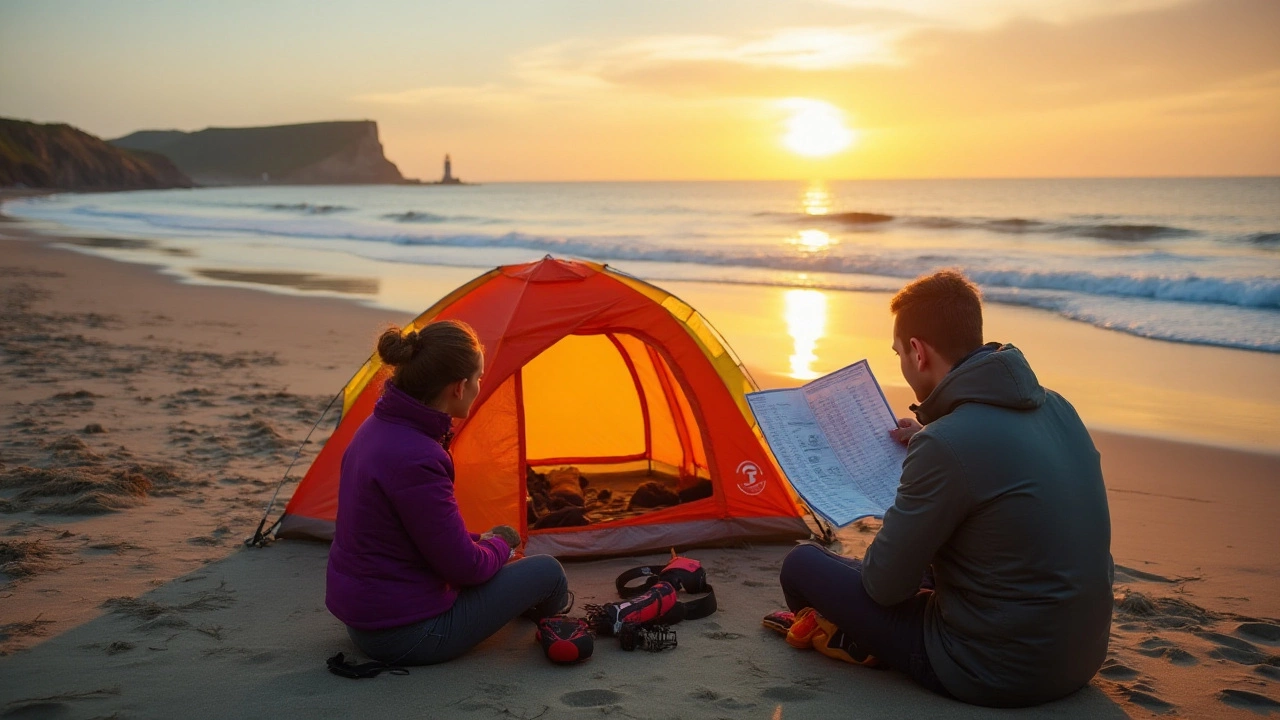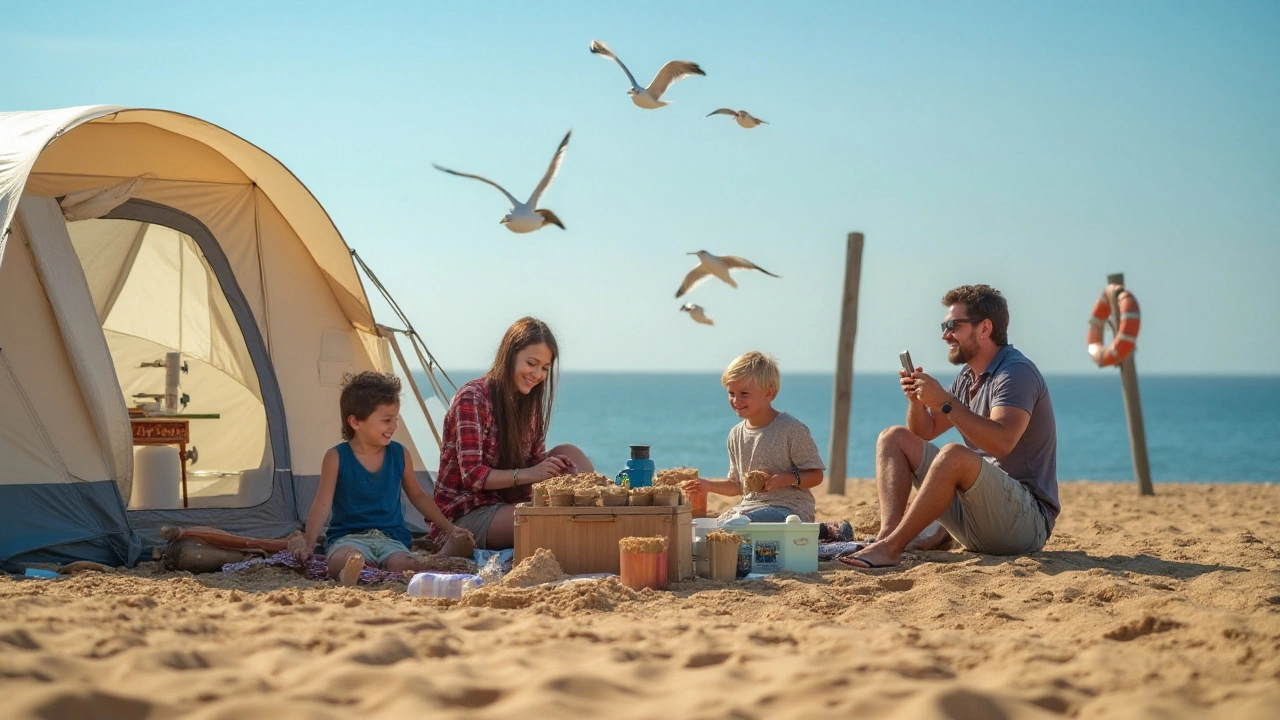Beach Camping: How to Safely Pitch a Tent on the Shore
 Oct, 20 2024
Oct, 20 2024
Camping on a beach can be an extraordinary way to connect with nature while enjoying the soothing ambiance of the ocean. Imagine falling asleep to the gentle roar of waves and awakening to a picturesque sunrise over the water. However, before you embark on this serene adventure, there are vital aspects to understand and plan for.
Beaches offer unique environments that require a different approach from traditional camping spots. Knowing where and how to pitch your tent is essential to ensure not just comfort but also safety. This article will guide you through the ins and outs of setting up camp on a sandy beach, considering the ever-changing tides and potential wildlife encounters.
From choosing the perfect location to understanding local rules and regulations, preparing for a beach camping trip involves thoughtful planning. Whether you're seeking solitude or family-friendly fun, a successful beach camping experience is within reach with the right tips and tricks.
- Understanding Local Regulations
- Tide and Weather Considerations
- Choosing the Right Spot
- Essential Gear and Setup Tips
- Beach Wildlife and Conservation
Understanding Local Regulations
Camping on a beach might seem like a spur-of-the-moment decision, but it's vital to start by getting to grips with local regulations. Just because a stretch of sand looks inviting, doesn't mean camping is permitted. Always check if the beach you have in mind allows camping, as many places have strict rules to preserve their natural beauty. Regulations vary from area to area. For instance, some states allow beach camping overnight, while others only permit day-use.
Authorities often impose these rules to protect the delicate ecosystems and ensure public safety. It's not just about keeping the beaches pristine but also about safeguarding wildlife that calls these beaches home. For example, some regions may restrict camping during certain seasons to protect the nesting grounds of sea turtles. The loggerhead sea turtles, a frequent guest on the Florida beaches, receive extra protection from May through October, which restricts human activities around their nests.
Moreover, facilities such as toilets or designated fire pits may be available depending on local policies. Sometimes you need to secure a permit before setting up your tent. Obtaining this permit might involve a simple online application or a trip to the local ranger station. Beach camping permits often have associated fees; however, the benefit is ensuring you have a designated spot, often with essential amenities.
Consulting the local council or coastal authority can shed light on all this necessary information. Their websites often have sections dedicated to recreational activities including beach camping. It’s useful to have this information at hand before pitching your tent and receiving an unexpected fine. Knowing what you’re allowed to do can make the difference between a peaceful night beneath the stars and being disrupted by a flashlight-bearing officer.
A little-known fact about beach camping is that it may come with restrictions on specific activities. For instance, building a campfire is not allowed on some beaches due to the risk of wildfires. In these situations, portable camping stoves become must-have gear. If campfires are permitted, take note of any regulations regarding the size of the fire and how to safely extinguish it. Always remember to pack enough soil or sand to adequately cover the ashes once you're done.
Don't forget to respect rules about keeping a safe distance from the water. Tides can rise unexpectedly, and knowing the precise spot for tent pitching according to local jurisdiction prevents any overnight surprises. Expert camper and writer John Morgan once said, "The magic of beach camping is in every crashing wave, yet respecting the rules ensures that magic isn't spoiled by the wrong kind of tide."
Many beaches will have signs posted that highlight these key regulations, and failing to adhere can result in fines or even eviction from your chosen camping spot. So always start your beach camping with a keen look at the rules, because once you're settled in and gazing out at the endless horizon, the last thing you want is to pack up and leave—except when it's time to head home.
Tide and Weather Considerations
When planning to set up your tent on the beach, understanding the area's tide patterns and weather is crucial. The tides can have a dramatic impact on your beach camping experience. Tides are caused by the gravitational pull of the moon and, to a lesser extent, the sun. They result in water levels rising and falling at the coastline. Most beaches experience two high and two low tides each day, which means timing your tent setup to avoid getting caught in a rising tide is important. About six hours separate high and low tides, so having a tide chart or using a tide app will help you plan. It's essential not to set your tent too close to the waterline, even if the tide seems low, as it could rise significantly overnight.
The weather at the beach can be unpredictable, and changes in conditions can happen quickly. A sunny day can turn to stormy skies within a couple of hours, influenced by offshore weather systems. Coastal weather forecasts are available online and via apps, which provide detailed updates and allow you to keep track of impending weather changes. Wind is another factor to consider, as strong gusts are more common on the beach. An unexpected squall can make camping both challenging and unpleasant. Make sure you have a sturdy tent and that it is well-anchored with sand stakes to withstand winds.
"Understanding tidal patterns is essential for any coastal traveler, as it can drastically alter the terrain and risk profile of your campsite," advises Dr. Susan Lambert, an environmental scientist at Coastal University.
In terms of temperature, it’s not uncommon for beach areas to experience cooler nights than inland locations. The proximity to the water means that heat dissipates faster, which could lead to unexpectedly chilly nights. Packing layers is a good idea; a light jacket or warm sleeping bag can make all the difference in keeping comfortable when the temperature drops.
Keep an eye on weather advisories and make sure you're prepared for sudden changes. This is not just about rain or wind; sometimes, heat waves can also pose a threat if you're not adequately sheltered or hydrated. It's smart to have a portable weather radio or use a handy app that sends notifications about weather alerts specific to your location. You don’t want to be caught off guard, especially when camping with family or friends, as they look up to you for a safe and enjoyable camping venture.
Here’s a quick checklist for tide and weather considerations:
- Check local tide charts and plan your setup away from high tide lines.
- Monitor weather forecasts and adjust your plans accordingly.
- Be prepared for high winds with appropriate tent stakes and equipment.
- Pack clothing layers to accommodate temperature changes.
- Ensure access to immediate weather updates through apps or portable devices.
The key here is preparation and knowledge, which can transform your beach camping outing into a smooth and enjoyable adventure.

Choosing the Right Spot
When it comes to beach camping, deciding where to set your tent is one of the most critical decisions you'll make. The beach can be an unpredictable environment, and finding the right spot can ensure a safe and comfortable experience. First and foremost, you must consider the tides. The mesmerizing beauty of the ocean can quickly turn hazardous if your tent is too close to the waterline. Checking tide schedules before selecting your spot is non-negotiable. You want to avoid waking up to water seeping into your bedding because the tide reached its high point while you slept. Be sure to set up camp on higher ground if available, and ideally, inspect the high tide line indicated by accumulated seaweed or debris.
Another important factor is privacy and safety. While the beach might be wide open, you'll want to choose a place that offers some protection, either from natural features like dunes or vegetation that can serve as a windbreak. This doesn't just grant you privacy, but it also helps shield you from the strong coastal winds that can disrupt your camp. If you're looking to set up camp in a more populated beach area, try to find a spot that gives a buffer zone between your tent and any other groups, ensuring your privacy and safety.
A seasoned camper once said, "Setting your tent up in the dunes can sometimes be your best choice. It gives some cover from wind and peeking eyes, but watch out for wildlife!"
Sun exposure should also be a consideration when selecting your beach camping spot. Shade can be scarce on a beach, and too much sun can lead to heat exhaustion or sunburn. If natural shade is not available, carry a tarp or beach umbrella to provide respite during the hotter midday hours. Don't forget to look for a spot away from the main thoroughfares of foot traffic to avoid interruptions and disturbances from other beachgoers.
Another thing to ponder is proximity to facilities. Even though camping is all about getting away from it all, having a bathroom and clean water supply nearby can be incredibly convenient. If you're staying at a designated beach campsite, proximity to these amenities can make a significant difference in comfort levels. Moreover, consider emergency access; choose a site that can be reached easily in case of an emergency but is far enough from roads to ensure you aren't disturbed by vehicle noise.
Additionally, observe the terrain where you plan to pitch your tent. While sand might seem like a welcoming surface, it can be deceiving. Opt for packed sand over loose sand to ensure your tent has stability. Some campers use sandbags or special stakes designed for sandy conditions to anchor their tents securely. Depending on where you are, local wildlife could also be a factor. Survey the area for signs of critters like crabs or birds who might be feasting on something nearby.
| Factors to Consider | Importance |
|---|---|
| Tide Lines | High |
| Wind Protection | Medium |
| Shade Availability | Medium |
| Proximity to Facilities | Low |
To sum up, choosing the perfect spot involves a mixture of safety mindfulness, logistical planning, and a touch of intuition. The ideal location balances the beauty of the beach with practicality, allowing you to enjoy your seaside adventure while keeping yourself and your companions safe. As you scout for that sweet spot, imagine a little slice of paradise where all these elements come together to offer an unforgettable camping experience.
Essential Gear and Setup Tips
When planning your beach camping adventure, ensuring you have the right gear is crucial for comfort and safety. The beach environment can be notably different from forest or mountain settings, and being prepared for these unique conditions will make all the difference in your experience. First, consider the tent itself. You want a tent that's resistant to the wind, waterproof, and easy to set up on sandy or uneven ground. A tent with a good ventilation system is a lifesaver in warm, humid coastal areas. Sand stakes, which are larger and designed to grip better in sand, are a smart investment. Standard stakes can often fail to hold effectively in loose sand, leading to potential headaches.
Not just your tent, but every piece of gear needs consideration for the beach. Sleeping mats or pads, specifically those designed for insulation, are helpful, as the ground can become surprisingly cold at night, even with the sand. Bring tarpaulins or ground cloths to place under and over your tent for added protection. Understanding the climate and potential weather changes is important, so pack extra tarps or ropes. These can be used to create makeshift awnings to shield from the sun or rain. A mesh food cover can prevent unwanted sand in your meals, and portable stoves are often more practical than attempting to kindle a fire on the beach, where it's often prohibited.
The secret to a successful beach camping trip is all about striking the right balance between comfort and practicality. As John R. Perry, noted outdoor enthusiast, once said, "Prepare for the worst, enjoy the best." Keeping this mindset will ensure you're ready for the unexpected while reveling in your seaside sanctuary.
In addition to shelter and food preparation, proper clothing is another critical consideration. Dress in layers to handle the variance between daytime warmth and nighttime chill. Breathable fabrics with UV protection are ideal, preventing sunburn while keeping you comfortable. Don't forget a wide-brimmed hat and sunglasses. The sun's reflection off the water can cause increased exposure. A high SPF sunscreen is essential, and it's wise to reapply frequently, especially after swimming or perspiring. Being proactive with sun protection allows you more freedom to enjoy your time outdoors.
Lights and Navigation
As any experienced camper will tell you, effective lighting can make or break your trip, especially when camping on a beach. A bright headlamp is invaluable, leaving your hands free for cooking or setting up gear. Solar-powered string lights can create a cozy atmosphere and make navigating around your site easier when the sun goes down. Backup power sources, like extra batteries or solar chargers, should always be on your list, ensuring that you’re not left in the dark when you need to find your way back from a moonlit walk along the shore. Having a detailed map or a GPS device doesn't hurt either, aiding you in recognizing nearby landmarks and staying oriented.

Beach Wildlife and Conservation
When it comes to beach camping, embracing the local wildlife becomes part of the experience and an important aspect to respect. Beaches are bustling ecosystems that serve as homes for an array of species, from tiny crabs scuttling along the sand to majestic seabirds soaring overhead. Understanding the delicate balance of this environment is crucial for ensuring your camping trip leaves only footprints behind. Whether you find yourself watching a line of pelicans skimming across the water or spotting the subtle tracks of a sea turtle, appreciating these natural wonders up close is a privilege that comes with responsibility.
Many beach campers may be surprised to learn about the crucial role that beaches play as breeding grounds for numerous marine creatures. Sea turtles, for instance, rely on coastal shores for laying their eggs, digging deep pits in the sand to house their precious cargo. Ensuring minimal disturbance to these areas is vital. Watching a mother turtle emerge from the ocean to nest can be a magical sight, but it's imperative to maintain a respectful distance since human interaction can disrupt their natural behavior. Conservation efforts often have designated areas on beaches, signposted to protect such wildlife activities. Always camp outside of these zones to support ongoing conservation efforts.
"We found that beaches with well-managed conservation practices saw an increase in nesting turtle populations," said Dr. Elaine Thompson, a leading marine biologist. "When campers and visitors respect protected areas, wildlife can thrive at astonishing rates."
Recognizing that beaches are not only playgrounds for campers but also havens for migratory birds is another key aspect of conservation. Flocks of birds like sanderlings and plovers can be seen feasting on tiny organisms along the shore. These birds rely on undisturbed areas to feed and rest during their long journeys. By keeping noise levels down and respecting bird nesting areas, campers can help ensure these vital bird populations are not adversely affected. In some regions, you may even spot rare species, adding an unexpected delight to your camping experience.
Beyond simply observing wildlife, engaging in conservation practices helps maintain these precious ecosystems. Carry biodegradable bags to collect any trash you might generate, and if possible, participate in beach clean-up activities. Such efforts not only preserve the natural beauty of the beach but also protect marine life from the threats posed by pollution. Leaving no trace of your camping presence means future beach campsites remain pristine for everyone to enjoy. Furthermore, consider supporting local conservation initiatives, which often rely on donations and volunteers to continue their essential work.
To help visualize the kind of impact that beach camping can have on local wildlife and conservation awareness, here’s a simple way to see what your respectful behavior can translate into for local wildlife:
| Action | Immediate Impact | Long-term Benefit |
|---|---|---|
| Using biodegradable products | Reduced waste on the beach | Healthier ecosystems for marine life |
| Respecting wildlife | Less stress on animal populations | Increase in nesting success rates |
| Participating in clean-ups | Less litter on the beach | Enhanced biodiversity |
For campers, understanding and contributing to beach conservation efforts improves not only their own experience but also helps sustain the natural wonders of seaside environments. This mutual respect between campers and the natural world fosters a healthier ecosystem for everyone to enjoy and cherish. Remember, when the tide washes away your footprints, your legacy of conservation should linger beautifully on the sandy shores.